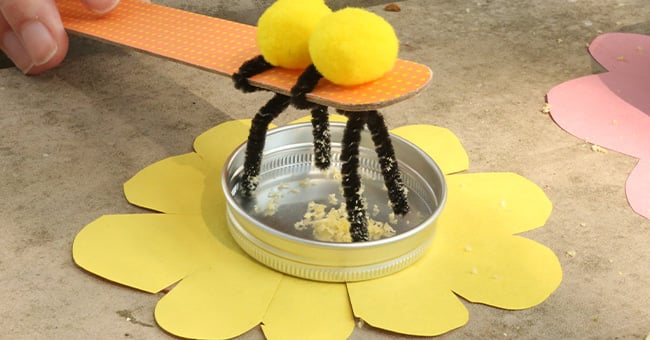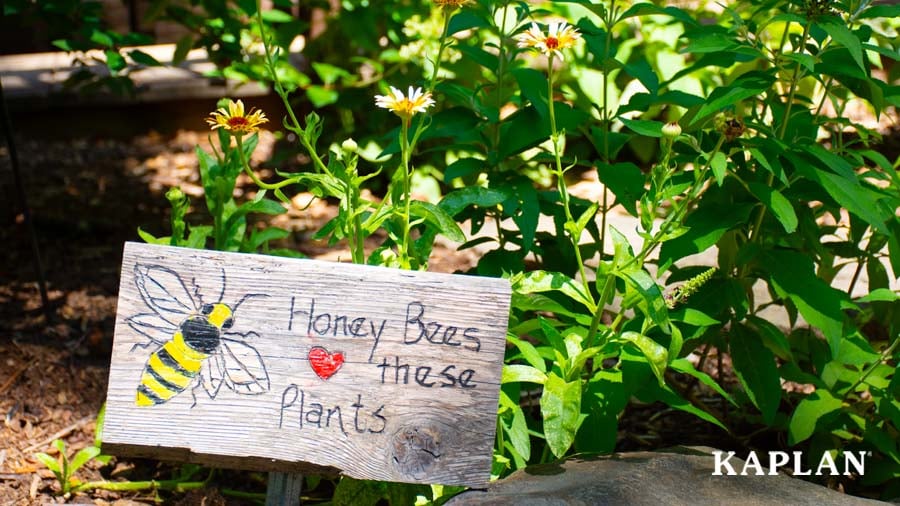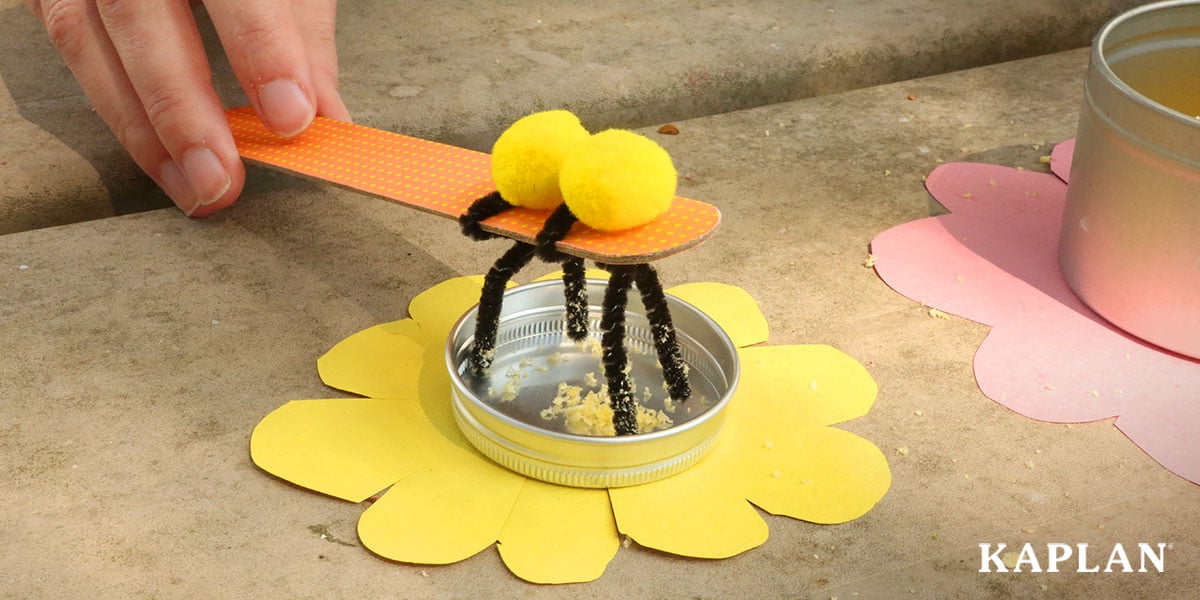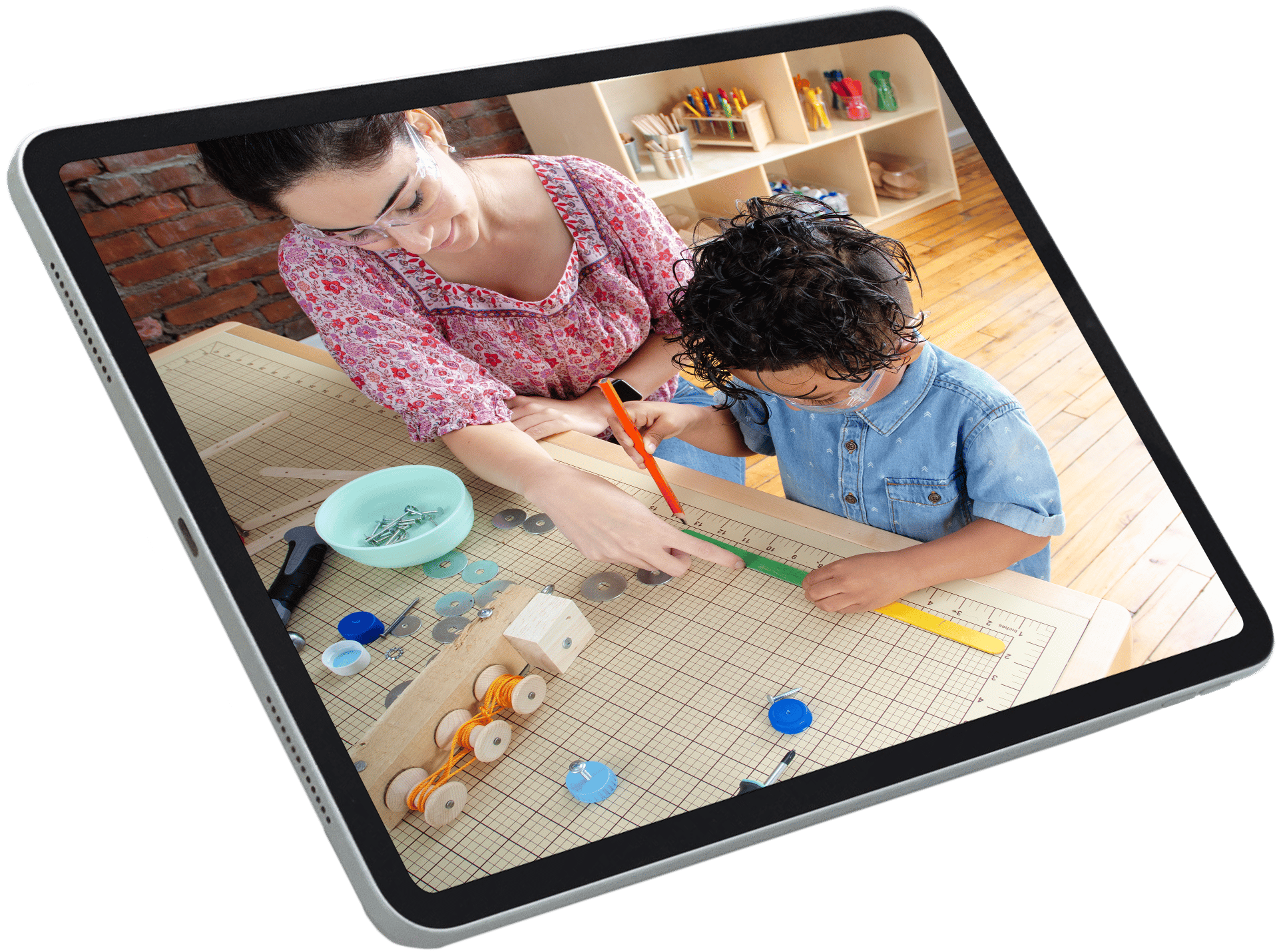
Bees are incredibly valuable to our ecosystems and environments due to their role as pollinators. While flying from flower to flower, they help plants produce seeds, fruits, and/or vegetables that nourish plants, animals, humans, and other living organisms.
While bees may be small, they offer big learning opportunities for young children. From understanding life cycles and pollination to recognizing the importance of environmental care, learning about bees helps children connect scientific concepts to their view of the world in meaningful ways.
In this exciting activity, children will create their own bees and carry out the process of pollination as they fly the bees from flower to flower. As they play and explore, children will begin to see how living things work together and why bees are essential to producing the food we eat and preserving the overall health of our planet. With bee populations in steady decline, it’s never been more important to help the next generation appreciate the role these tiny insects play in our environment.
How does Kaplan ensure that this activity is age-appropriate and supports the educational needs of children ages 3 to 6?
With over 50 years of experience in early childhood education, Kaplan understands the importance of classroom activities that reflect the latest research and align with educational best practices. We designed this activity with inspiration from the Gryphon House books The Giant Encyclopedia of Preschool Activities for Four-Year-Olds and Simple Steam: 50+ Science, Technology, Engineering, Art, Math Activities for Ages 3 to 6 as well as the pre-K curriculum Connect4Learning®.
This activity is a perfect addition to daily art center and small group lessons.
Bee Pollination
In this Bee Pollination activity, children are introduced to the world of bees and their role as pollinators.
You’ll begin with a group discussion on the topic that will help children connect the activity to the world around them. Books such as The Honeybee by Kirsten Hall and Give Bees a Chance by Bethany Barton will help facilitate this discussion. During the discussion, explain to children the different parts of a flower, the significance of pollen, why bees collect pollen, and other concepts relevant to pollination. Conversations and activities about bees, plants, flowers, and pollination can help children:
- Develop a curiosity about the natural world
- Discover how pollination (and bees) help create the food that they eat (such as apples, oranges, and almonds)
- Cultivate empathy by adopting the perspective of another living being
- Expand their vocabulary with new words such as “pollen” and “vector”
Materials:
- Peel & Stick Pom Poms
- Jumbo Natural Craft Sticks
- Black Chenille Stems
- Construction Paper
- Scissors
- Yellow paint for the pollen
- One paint cup for the flower with the pollen
The Activity:
Before the activity begins, turn one of your classroom’s flat surfaces into a lovely flower garden. Use scissors and construction paper to craft colorful two-dimensional flowers of all shapes and sizes. Give each flower enough space in the middle to hold the “pollen” that the bees will bring them. You can designate this space with more construction paper or with a marker. Once you have made and laid out your flowers, choose one to act as the pollen source. Put a paint cup on this flower and fill it with yellow paint to mimic pollen.
Once your garden is complete, lay out all the materials children will use to make their flying, buzzing bee friends. To start, prompt each child to choose a wooden craft stick for their bee’s body and two chenille stems for their bee’s legs. Help children secure the legs to the craft stick by wrapping the chenille stem around the craft stick at least two times. Next, prompt children to give their bee a fuzzy body by securing the pom pom balls to the craft stick. Encourage children to make AB or AABB patterns with yellow and black pom poms to mimic the bee’s realistic colorations.
As the children bring their bee friends to life, you can encourage their creative thinking by asking questions such as:
- “What sound do you think your bee will make as it flies?”
- “If the pom poms on your bee’s body make a pattern, what color will come next?”
With their bees in hand, it is time for the children to take their bee on a pollination adventure in the flower garden! First, prompt children to take turns dipping their bees in the paint cup until the bees get “pollen” on their legs. Children will then fly their bee to another flower and gently tap its legs on the middle of it. Prompt children to investigate the flower their bee just visited to see if it transferred any pollen. If so, praise them for successfully pollinating a flower with their bee. If not, encourage the child to pick up more pollen from the first flower and try again. To make the activity even more fun, ask children to make buzzing noises (demonstrate if necessary!) or move their bee in a zigzag motion while they fly.
Once all the children in your group have a chance to practice pollination, set a timer for five minutes. Start the timer and encourage the children to use their bees to pollinate as many flowers as possible. As they work hard to move pollen from flower to flower, pose thought provoking questions such as:
- “When your bee landed on the purple flower, it didn’t give it any pollen. What should your bee do to get more pollen for the purple flower?”
- “If the green flower doesn’t get any pollen from the bee, will it produce a fruit or vegetable?”
- “How many flowers do you think your bee will pollinate after dipping in the pollen three times?”
How can you incorporate math development into the Bee Pollination activity?
There are multiple ways that you can modify this activity to promote early math skills. First, you can design the flowers in a way that promotes math skills. For example, put a number on each flower and emphasize those numbers with prompts such as:
- “You just pollinated flower number 1. Can you go pollinate flower number 2 now?”
- “Flower number 3 doesn’t have much pollen. Can you go give it some more?”
Another option is to give each flower a different number of petals and have children count the flower’s petals as they pollinate it.
For ideas that don’t involve flower design, ask children to count the number of pom poms on their bee and then pollinate that many flowers or count the number of steps they take to pollinate a flower.

How can you incorporate literacy development into the Bee Pollination activity?
You can also give the activity a literacy focus. Mark each flower with a letter, ask one child to pollinate flower A, and ask another child to pollinate flower B. Ask children to tell you the first letter of the flower’s color that they’re about to pollinate. Have children say a flower’s letter out loud as they go to pollinate it. Make literacy part of the pollination process by asking children to paint the flower’s letter with their pollen.
To go beyond letter-related activities, have children describe the journey of their bee. Ask them to tell you where the bee is going and what it will do once it gets there. This will develop children’s imaginative thinking skills and enable them to use and expand their vocabulary.
What inspired this activity?
We created this activity based on inspiration from Gryphon House books, namely The Giant Encyclopedia of Preschool Activities for Four-Year-Olds and Simple Steam: 50+ Science, Technology, Engineering, Art, Math Activities for Ages 3 to 6. If you enjoyed this activity, these books have many more ideas for activities that will develop children’s scientific knowledge as well as their math and literacy skills.
Ready to introduce the Bee Pollination activity to your classroom?
Adding this activity to your classroom will enhance children’s knowledge of the natural world and strengthen important skills in math and literacy. Use this activity to inspire your weekly lessons, and feel free to make changes to better suit the needs of the children in your care.
Don’t forget to download a PDF version of this activity to quickly and easily refer to the materials list, activity details, and enrichment opportunities.


